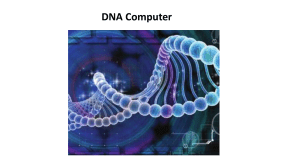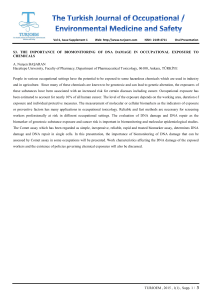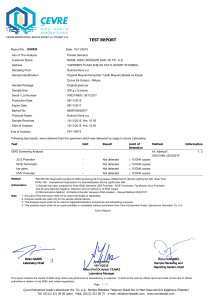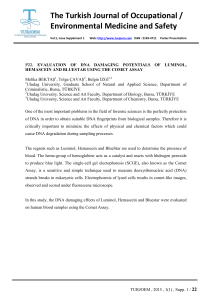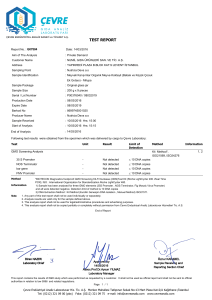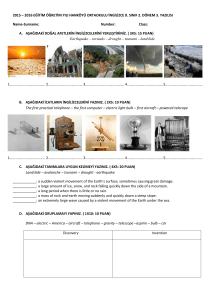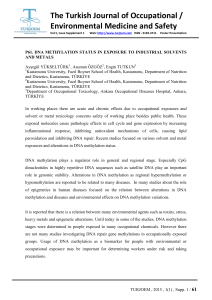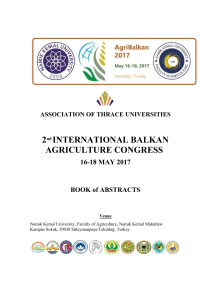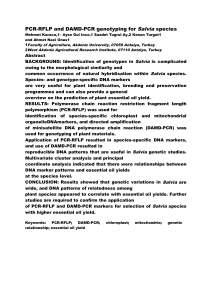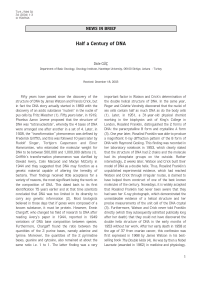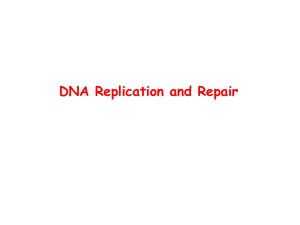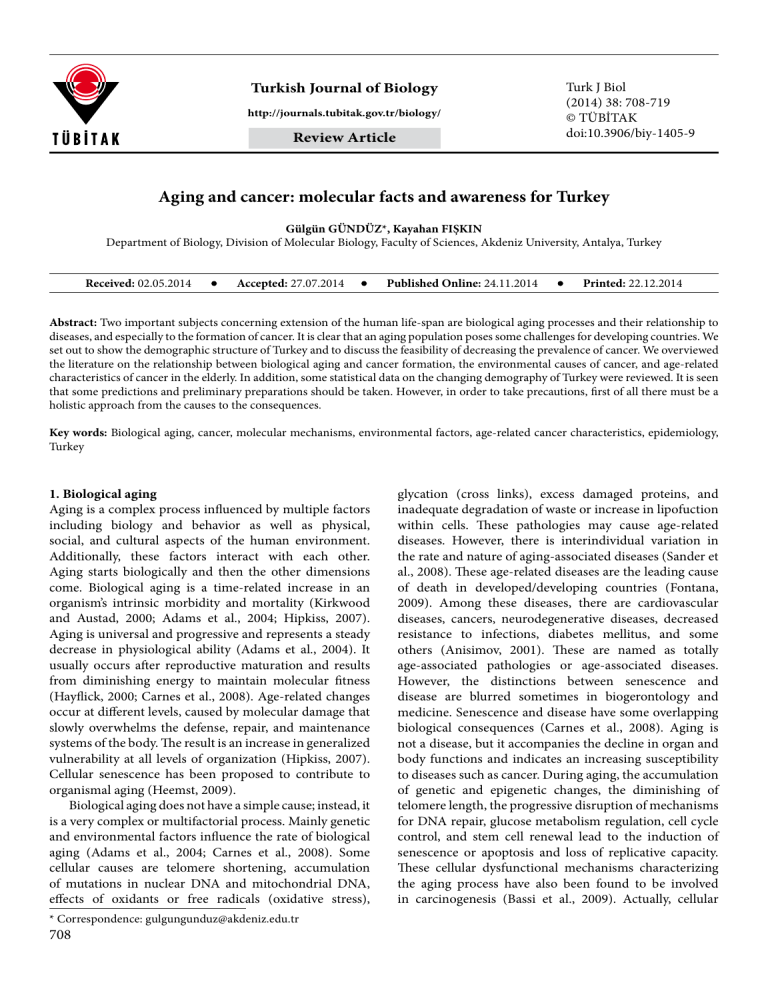
Turkish Journal of Biology
http://journals.tubitak.gov.tr/biology/
Review Article
Turk J Biol
(2014) 38: 708-719
© TÜBİTAK
doi:10.3906/biy-1405-9
Aging and cancer: molecular facts and awareness for Turkey
Gülgün GÜNDÜZ*, Kayahan FIŞKIN
Department of Biology, Division of Molecular Biology, Faculty of Sciences, Akdeniz University, Antalya, Turkey
Received: 02.05.2014
Accepted: 27.07.2014
Published Online: 24.11.2014
Printed: 22.12.2014
Abstract: Two important subjects concerning extension of the human life-span are biological aging processes and their relationship to
diseases, and especially to the formation of cancer. It is clear that an aging population poses some challenges for developing countries. We
set out to show the demographic structure of Turkey and to discuss the feasibility of decreasing the prevalence of cancer. We overviewed
the literature on the relationship between biological aging and cancer formation, the environmental causes of cancer, and age-related
characteristics of cancer in the elderly. In addition, some statistical data on the changing demography of Turkey were reviewed. It is seen
that some predictions and preliminary preparations should be taken. However, in order to take precautions, first of all there must be a
holistic approach from the causes to the consequences.
Key words: Biological aging, cancer, molecular mechanisms, environmental factors, age-related cancer characteristics, epidemiology,
Turkey
1. Biological aging
Aging is a complex process influenced by multiple factors
including biology and behavior as well as physical,
social, and cultural aspects of the human environment.
Additionally, these factors interact with each other.
Aging starts biologically and then the other dimensions
come. Biological aging is a time-related increase in an
organism’s intrinsic morbidity and mortality (Kirkwood
and Austad, 2000; Adams et al., 2004; Hipkiss, 2007).
Aging is universal and progressive and represents a steady
decrease in physiological ability (Adams et al., 2004). It
usually occurs after reproductive maturation and results
from diminishing energy to maintain molecular fitness
(Hayflick, 2000; Carnes et al., 2008). Age-related changes
occur at different levels, caused by molecular damage that
slowly overwhelms the defense, repair, and maintenance
systems of the body. The result is an increase in generalized
vulnerability at all levels of organization (Hipkiss, 2007).
Cellular senescence has been proposed to contribute to
organismal aging (Heemst, 2009).
Biological aging does not have a simple cause; instead, it
is a very complex or multifactorial process. Mainly genetic
and environmental factors influence the rate of biological
aging (Adams et al., 2004; Carnes et al., 2008). Some
cellular causes are telomere shortening, accumulation
of mutations in nuclear DNA and mitochondrial DNA,
effects of oxidants or free radicals (oxidative stress),
*Correspondence: gulgungunduz@akdeniz.edu.tr
708
glycation (cross links), excess damaged proteins, and
inadequate degradation of waste or increase in lipofuction
within cells. These pathologies may cause age-related
diseases. However, there is interindividual variation in
the rate and nature of aging-associated diseases (Sander et
al., 2008). These age-related diseases are the leading cause
of death in developed/developing countries (Fontana,
2009). Among these diseases, there are cardiovascular
diseases, cancers, neurodegenerative diseases, decreased
resistance to infections, diabetes mellitus, and some
others (Anisimov, 2001). These are named as totally
age-associated pathologies or age-associated diseases.
However, the distinctions between senescence and
disease are blurred sometimes in biogerontology and
medicine. Senescence and disease have some overlapping
biological consequences (Carnes et al., 2008). Aging is
not a disease, but it accompanies the decline in organ and
body functions and indicates an increasing susceptibility
to diseases such as cancer. During aging, the accumulation
of genetic and epigenetic changes, the diminishing of
telomere length, the progressive disruption of mechanisms
for DNA repair, glucose metabolism regulation, cell cycle
control, and stem cell renewal lead to the induction of
senescence or apoptosis and loss of replicative capacity.
These cellular dysfunctional mechanisms characterizing
the aging process have also been found to be involved
in carcinogenesis (Bassi et al., 2009). Actually, cellular
GÜNDÜZ and FIŞKIN / Turk J Biol
senescence is a potent tumor suppressive mechanism. That
is, there is damage or stress-induced cellular senescence in
order to prevent risky cells from initiating tumorigenesis.
Malignant tumorigenesis requires the genetic or epigenetic
inactivation of at least one, and often both, of the tumor
suppressor pathways, thereby enabling initiation of cancer
cells to bypass the senescence checkpoint (Campisi et al.,
2011).
2. Accompanying molecular mechanisms of aging and
cancer
Aging and carcinogenesis share many molecular pathways.
Aging includes a number of events at molecular, cellular,
and physiological levels that also influence carcinogenesis.
With the exception of germ cells and stem cells, most
somatic cell types have a limited proliferative life-span.
Indeed, this limitation may have evolved as a protective
mechanism against cancer (Anisimov, 2009). However,
the most significant risk factor for developing cancer
is aging. The incidence of adult human cancers shows a
relationship with age (Kennedy et al., 2012). Aging may
increase or decrease the susceptibility of different cells
or tissues to tumor development and may affect cancer
initiation and progression in many ways (Anisimov, 2009;
Hornsby, 2011). Therefore, growing older is a greater risk
factor for developing cancer. About 80% of all cancers are
diagnosed in people over 50. Thus, with the increase in the
aging population, it is expected that cancer will become a
more and more serious problem. Findings point out that
some of the constantly active molecular mechanisms that
defend cells from cancer transformation are increasingly
disrupted with aging and may be involved in aging and in
cancerogenesis (Bassi et al., 2009).
Cancer is the second cause of death in many developed
countries (~25% of deaths) (Bassi et al., 2009; Fontana,
2009). Cancer is a complex multistep molecular genetic
disease associated with the accumulation of multiple
forms of DNA damage that cause a disorganization of cell
proliferation and differentiation, and eventually tissue
invasion and dislocation to distant sites. If not properly
controlled through induction of senescence or apoptosis,
accumulation of multiple DNA mutations in critical genes
can disturb the cell proliferation process and progressive
transformation of normal human cells into malignant tumor
cells. Additionally, the surrounding microenvironment
and the cell interactions between cancer cells play an
important role in tumor cell proliferation, tissue invasion,
and metastasis, which are ultimately responsible for ~90%
of human cancer deaths (Longo et al., 2009). Cancer is
relatively rare in young mammals, because they have more
active tumor suppressor mechanisms. The incidence of
malignant tumors increases with age, but patterns of agerelated tumors are different for tissues (Anisimov, 2009).
With longer life-spans, there is increased risk for both DNA
damage and long-term exposure to carcinogens. Therefore,
older adults may have greater potential for accumulated
molecular damage coexisting with age-related decreased
cellular repair activity causing malignancies (CloughGorr et al., 2012). During their total life time, aging
cells accumulate many DNA mutations and unrepaired
lesions, defective mitochondria, progressively shortened
telomeres, heterochromatic silencing, misfolded or
carbonylated proteins, and oxidized biomolecules because
of reactive oxygen species (ROS) (Kennedy et al., 2012).
2.1. Telomere length
One of the earliest observations on age-related decline in
proliferative capacity of cells was described as the result
of telomere shortening. In general, telomere dysfunction
causes either senescence or crisis in human tissues and
there is an association between telomere length and the
markers of senescence in tissues in vivo. Telomere length
is a major factor in the anticancer action of cellular
aging (Hornsby, 2011). Telomeres stabilize the integrity
of chromosomal ends. They compensate for incomplete
semiconservative DNA replication at each chromosomal
end. They protect against homologous recombination and
nonhomologous end joining (Bassi et al., 2009; Sikora
et al., 2011). When somatic cells divide, usually a short
terminal telomeric repeat region of DNA is not replicated.
This works as a kind of mitotic counter. The shortening of
telomeres causes telomere dysfunction and a permanent
inability for cell division occurs. Damage may also result
from a susceptibility of telomeres to DNA damage from
other causes such as oxidative stress (Hornsby, 2011). The
critical shortening of telomeres limits cells to a particular
division number. The cell detects this phenomenon as
DNA damage and enters a cellular replicative senescence.
The limited number of cell divisions plays an important
role in cancer suppression. Telomere length is replenished
by the telomerase. This enzyme is active in germ and
stem cells. Most of the cancer cells bypass the protective
phenomenon of senescence and become immortalized
by telomere extension due to the overexpression of the
telomerase enzyme. There is telomere maintenance activity
in approximately 90% of cancers in almost all mammalian
organisms. It may be thought that the shortening of the
telomere and its restoring mechanisms is a trade-off
between molecular pathways of aging and cancer (Bassi et
al., 2009).
2.2. Genetic changes
Both nuclear DNA and mitochondrial DNA mutations
play important roles in aging and age-related pathologies.
Normally there are maintenance and repair systems
to overcome molecular damage. Sometimes both
mutations and disturbed DNA repair mechanisms may
act synergistically in causing cancer. Some DNA damages
709
GÜNDÜZ and FIŞKIN / Turk J Biol
and wrong mitogenic signals can also cause cells to
gain a senescent phenotype (Anisimov, 2009; Heemst,
2009). Biomarkers of cellular senescence in aging and
age-related diseases are chromosomal instability and
accumulation of DNA damage foci (Sicora et al., 2011).
That is, genomic instability is a key mechanism of both
aging and cancerogenesis. DNA damage at relatively low
levels is efficiently repaired. However, somatic mutations
accumulate in most organs and tissues. Aging and cancer
are linked to DNA damage and damaged processing is
linked to genome maintenance systems (Maslov and Vijg,
2009). When the balance between DNA damage and repair
is disturbed, it can accelerate age-associated diseases. The
loss of mitochondrial DNA integrity is also hypothesized
to play an important role in the aging process. Especially
in mitochondrial mutations, a hazardous cycle of
oxidative damage induced by ROS production may play
an important role in the aging process. MtDNA mutations
have direct roles in initiation of carcinogenesis and also
may have tissue susceptibility to metastatic potential
(Figure 1) (Kennedy et al., 2012).
2.3. Epigenetic changes
Not only mutations but also epimutations are also
important for aging and cancerogenesis. Epimutations or
epigenomic alterations are heritable and stable changes
in gene expression that do not affect the actual base pair
sequence of the DNA. There are epigenetic changes in
cellular senescence, aging, and age-related pathologies.
Epimutational damage causes stochastic changes in
differentiated cells and this is one of the causes of the
biological aging process (Maslov and Vijg, 2009). Somatic
epigenetic inheritance depends on some enzymes that
control methylation and histone acetylation in DNA.
DNA methylation regulates chromatin stability and gene
expression. The most important epigenetic changes are
the silencing of tumor suppressor genes and repair genes
and other genes involved in the control of cell cycle,
senescence, detoxification, and apoptosis. Genome-wide
hypomethylation was suggested as a step in carcinogenesis
and promoter region methylation in the gene appears as an
important mechanism of epigenetic inactivation of tumor
suppressor genes (Anisimov, 2009; Bassi et al., 2009).
2.4. Oxidative stress
The ROS are extremely reactive molecules and can damage
cellular components. ROS are generated and wiped out in
cells. They are produced by mitochondrial metabolism,
activation of nicotinamide adenine dinucleotide phosphate
oxidase, peroxisomes, cytochrome P450 enzymes,
nitric oxide synthase uncoupling, and the antibacterial
oxidative burst of inflammatory cells. They also arise
from exogenous sources, such as ultraviolet, ionizing
radiations and genotoxic agents. ROS include superoxide
anion, hydroxyl radicals, and hydrogen peroxide. These
extremely unstable compounds perform genotoxic
and cytotoxic activities through lipid peroxidation or
protein damage and may cause DNA replication errors,
Figure 1. Accumulation of somatic mutations during cancer formation.
During normal organismal aging, cells (blue) are continually exposed to
DNA damaging events, which eventually results in cells harboring multiple
mutations (red). Some mutations occur in regions of the genome that lead
to uncontrolled cell proliferation. The acquisition of a mutator phenotype
allows for more rapid somatic evolution that continually acts to select for cells
able to bypass many of the defense mechanisms that limit unrestricted cell
proliferation (from Kennedy et al., 2012).
710
GÜNDÜZ and FIŞKIN / Turk J Biol
spontaneous chemical changes in single- and doublestrand DNA breaks, adducts, and crosslinks. Oxidative
stress has some effects in cells such as accumulation of
mutations in genes, telomere shortening, and damage
in mitochondrial DNA. The free radical theory of aging
was developed in 1956 by Harman and argues that
aging results from ROS-generated damages (disputed by
several authors), suggesting that prevention of oxidative
stress may help to slow down the aging process. The
antioxidative system includes many types of antioxidants,
such as vitamins C and E, and enzymes such as superoxide
dismutase, catalase, and glutathione peroxidase. The
antioxidative defense mechanism of the body protects
cells from oxidative damage by scavenging harmful
ROS. If the amounts of ROS exceed cellular antioxidative
defense mechanisms, then the oxidative stress gets higher.
Homeostasis of ROS is important and essential for life and
it must be perfectly controlled. Intracellular high oxidative
stress has 2 potentially significant effects; the first is to
damage various cellular compounds and the second is to
trigger the activation of specific cell-signaling pathways.
Both effects may stimulate some cellular processes, aging,
and the development of age-related diseases, such as
cancer, because ROS are byproducts of energy production
in mitochondria and can damage mitochondrial DNA
over a short distance. Some mitochondrial damaged cells
undergo programmed cell death, apoptosis. Accumulation
of somatic mutations in mtDNA of tumor cells may also
contribute to tumor growth. MtDNA damage may cause the
insufficient expression of cellular components increasing
the portion of disrupted, ROS-producing oxidative
phosphorylation and eventually promoting the aging
process and carcinogenesis. In the end, mitochondrial
formation of ROS both causes and accelerates aging and
cancer development. With age, the antioxidant system
weakens and, therefore, oxidative damage is strengthened.
There is evidence supporting a relationship between ROS
and mutagenesis/cancerogenesis. Many cancer cells show
increased production of ROS, and normal cells exposed
to ROS show increased proliferation. Elevated ROS levels
may also directly induce DNA damage, leading to genomic
instability and cancer progression in the young (Anisimov,
2009; Bassi et al., 2009; Migliore and Coppede, 2009;
Okada et al., 2012).
2.5. Apoptosis
Apoptosis is programmed and genetically controlled cell
death. It can eliminate defective cells and protect organisms
from malignancy. However, the proportion of apoptosis is
important; a high proportion of apoptosis may give rise to
aged phenotypes. Senescent cells have some characteristics
such as increased ROS production, increased oxidative
damage, reduced heat shock protein expression, increased
glycation damage, accumulation of defective proteins,
and declined functions of apoptotic proteins. p53-related
apoptosis is a protective mechanism against uncontrolled
cell proliferation induced by oncogene activation.
Apoptosis may play a protective role against cancer in
some tissues, whereas cellular senescence may play a more
protective role in other tissues. The decrease in apoptosis
rate with age may promote cancerogenesis due to less
efficient cellular signaling and regulation (Anisimov, 2009;
Bassi et al., 2009).
2.6. Cell cycle control
Cell cycle checkpoints control the process in each cycle
period to be accurately completed before progression. The
genes of checkpoint proteins may be seen as a molecular
link between aging process and carcinogenesis (Bassi
et al., 2009). The tumor suppressor gene and its product
p53 can implement antiproliferative effects in response
to serious types of cell stress. Growth arrest, apoptosis,
and cell senescence are some antiproliferative effects. In
half of human tumors there are mutations within the p53
gene. Evidence indicates that tumors that have the wildtype p53 have other defects in the p53 pathway, which are
also important in the development of cancer (Yi and Luo
2010). p53 can induce both apoptosis and cell cycle arrest.
The decline in p53 response to stress at older ages may
contribute to an increase in cancer incidence (Bassi et al.,
2009). p53 may protect against cancer but at the cost of
longevity; that is, individuals carrying alleles indicated in
a low intensity of apoptosis are more vulnerable to cancer
but less vulnerable to strokes or myocardial infarction
(Yashin et al., 2009).
2.7. DNA repair mechanism
Cells are exposed to DNA damage continuously, via
normal metabolic activities and environmental factors.
DNA damage activates the defensive pathways of the
cell by inducing multiple proteins involved in cell
cycle checkpoints, DNA repair, protein trafficking, and
degradation. DNA repair involves some constantly
active processes by which a cell identifies and corrects
DNA damage. The cell may enter 1 of 3 possible states:
senescence, apoptosis, or unregulated cell division,
which can cause cancerogenesis. Some genes that have
been shown to influence organisms’ life-span and cancer
development are also involved in DNA repair pathways.
Normally, the cell cycle checkpoint control pauses the cell
cycle and gives time for the cell to repair DNA damage,
and thus it prevents cancerous transformation. There is a
link between DNA repair mechanisms, the aging process,
and cancer. This is also shown by some hereditary DNA
repair disorders. Additionally, there are some hereditary
malignancies associated with reduced DNA repair function
such as hereditary breast and colon cancer (Anisimov,
2009; Bassi et al., 2009).
711
GÜNDÜZ and FIŞKIN / Turk J Biol
2.8. Senescence-associated secretory phenotype
For malignant tumorigenesis, accumulation of somatic
mutations and a suitable tissue milieu are necessary. A
normal tissue microenvironment can suppress the ability
of mutant cancer cells to proliferate. However, a tissue
microenvironment may also gain a procarcinogenic
state independently of the presence of tumor cells. An
important procarcinogenic tissue milieu is age (Figure 2)
(Campisi et al., 2011). The number of senescent cells in the
body accumulates with time and those senescent cells are
predominantly present at sites of age-related pathologies.
Although most of the changes induced upon senescence
are beneficial, in the long term, some of these changes
may also have a negative impact on tissue functions and
integrity, especially if senescent cells accumulate in high
enough numbers. Senescent cells stay in permanent
growth arrest with changed morphology and function.
They usually gain a new phenotype with unusual secretory
properties because of distinct changes in their gene
expression pattern. Growth factors secreted by senescent
cells may especially induce premalignant cells to malignant
ones. Therefore, while beneficial for tumor suppression in
the short term, induction of cellular senescence may have
negative consequences later in life on the development of
aging diseases. These are related to the hypermitogenic
and secretory characteristic of senescent cells. These
may cause, paradoxically, the development of late-life
cancers (Heemst, 2009). Senescent cells secrete numerous
chemokines, cytokines, growth factors, proteases,
and insoluble components, and this new property is
called the senescence-associated secretory phenotype
(SASP). There are about 40 factors; some are involved in
intercellular inflammatory signaling. SASP occurs in some
proliferative cell types such as fibroblasts, endothelial
cells, and epithelial cells. SASP can have striking autocrine
and paracrine effects. The paracrine effects of senescent
cells are the ability to alter the behavior of neighboring
cells and the quality of the local tissue environment. The
paracrine feature of SASP can have beneficial or harmful
effects, depending on the physiological context. One of the
beneficial effects is, of course, tissue repair. One detrimental
effect is disrupting normal tissue structures and function,
thereby promoting malignant phenotypes in nearby
cells. (Campisi et al., 2011; Sikora et al., 2011). Normally,
senescent cells are eliminated by the immune system.
However, the aging immune system may become less
capable of clearing senescent cells, and/or some senescent
cells may escape from the immune system. In addition, the
production of senescent cells increases with age and leads
to an age-dependent acceleration of tissue damage. Some
experiments have shown that both senescent cells and
mutant premalignant cells accumulate highly with time.
The accumulation of damaged and senescent cells during
aging may be a source of some mobile proinflammatory
cytokines that cause pathologies in both local and distal
environments. Therefore, long-lasting inflammation may
predispose organisms to various types of cancer (Campisi
et al., 2011).
Figure 2. Senescent cells, by virtue of their SASP, may promote both the degenerative
and neoplastic diseases of aging. Both senescent cells and preneoplastic cells increase
with age in many tissues. The SASP of senescent cells can cause normal cells within
tissues to lose optimal function, leading to tissue degeneration. The SASP can also cause
premalignant cells to proliferate and adopt more malignant phenotypes, leading to fullblown cancer (from Campisi et al., 2011).
712
GÜNDÜZ and FIŞKIN / Turk J Biol
2.9. Stem cells
Adult stem cells are an in vivo source to replace the cells in
high turnover tissues throughout the entire life-span. The
regenerative capacity of an organism is determined by the
ability and potential of its stem cells. Therefore, aging may
be interpreted as signs of somatic stem cells aging. Some
studies on stem cells have indicated that not only genetic
and epigenetic alterations but also biochemical alterations
affecting somatic cells might have a role in stem cell aging
(Bassi et al., 2009). During aging, there is a reduction in
stem cells, and this decline may indicate the relationship
between cancer incidence and age. There is an exponential
increase in the incidence of cancers with a peak around
80 years of age. All cancers show a decline in incidence
after this age. Probably, the reduced number of stem
cells limits the probability of generating the mutations
turning a stem cell into a cancer cell in those late years.
It is accepted that there is a balance between quantity and
quality of stem cells, which ensures a natural life-span
free of cancer and aging long enough for maturation and
reproduction. The stem cells, which are still active in old
age, may be functionally impaired because those inevitable
errors of genome maintenance accumulate throughout
the life-span. The increasing amount of mutations and
epimutations in the proliferation-capable stem cells
increases the risk of neoplastic transformation. However,
some tissues accumulate mutations and epimutations
and deplete stem cell populations at the same time. As we
know, tissue regeneration is maintained by somatic stem
cells; however, most malignancies are associated with
tissues containing an active stem cell population (Figure
3) (Maslov and Vijg, 2009). Our stem cells also grow old
as a result of mechanisms that prevent the development
of cancer. The specific environment of a stem cell is called
the niche and provides the adhesive support to maintain
the stem cells within the tissue. During the aging process,
the accumulation of mutations in the niche may cause
disruption of the normal mechanisms. Mutations damage
compartments of stem cells and in the end cause the
aging of organs and the body. This disruption may cause
pathological stem cell proliferation. The cancer stem cell
hypothesis states that tumors contain a reservoir of selfrenewal cells that share similar biological properties with
normal adult stem cells (Bassi et al., 2009).
2.10. Inflammation
Low systemic inflammation is important in aging.
It is known that the genes regulating the immune
inflammatory responses are involved in longevity. Thus,
inflammatory markers may be real predictors of mortality
in the elderly. The proinflammatory status of the elderly
causes functional decline and age-related diseases. In other
words, these diseases may be initiated or worsened by
systemic inflammation. Because of a low-grade activation
Figure 3. Hypothetical relationship among aging, cancer and
stem cells (SC). Various endogenous and exogenous factors
(e.g., ROS, replication errors, environmental hazards) cause
DNA damage, also in stem cells. Among the cellular responses
to DNA damage, apoptosis and senescence lead to attrition of
stem cell populations, while DNA repair may lead to errors both
increasing cancer risk and adversely affecting function. Hence,
cancer and noncancer degenerative dysfunction can both be
consequences of stem cells’ responses to DNA damage (from
Maslov and Vijg, 2009).
of the immune system by a lifetime of exposure to a variety
of antigens/pathogens, levels of circulating inflammatory
mediators may increase. Lifelong exposure to infections and
inflammatory status may increase the risk of heart attacks,
strokes, and cancer. People with genetic predisposition to
a low inflammation characteristic have a reduced chance
of developing age-related inflammatory diseases and an
increased chance of becoming a centenarian. Centenarians
and their children have a good chance of avoiding agerelated diseases including cancers (Castel et al., 2007;
Vasto et al., 2009). There is a strong association among
chronic infection, inflammation, and cancer. ROS released
at the site of inflammation play a role in carcinogenesis.
Interleukin-6 (IL-6) is involved in immune response and
inflammation. To cope with inflammation or as a strategy
for the treatment of chronic inflammatory diseases,
targeting IL-6 is thought to have therapeutic potential.
The proinflammatory cytokine tumor necrosis factor
(TNF)-α is also an important inflammation mediator.
Some studies have reported that there is a high amount
of it in autoimmune and inflammatory diseases, including
the age-related ones, and that it does not provide longevity.
713
GÜNDÜZ and FIŞKIN / Turk J Biol
TNF-α is involved in the pathogenesis of cancer, mainly
due to chronic inflammation, because it triggers DNA
damage, angiogenesis, invasion, and metastasis. Regarding
another interleukin, IL-10, genotypes producing low
amounts of it seem to play a role in the susceptibility to
inflammatory diseases. Conversely, genotypes producing
high IL-10 are involved in the accession of longevity. It is
thought that chronic inflammation caused by persistent
infections by microorganisms may be a driving force in
cancer development (Castel et al., 2007; Vasto et al., 2009).
Therefore, the relationship among the cellular
pathways of senescence, apoptosis, and cancerogenesis is
highly complex. Senescence and apoptosis are anticancer
mechanisms that generally appear to promote aging, but
adversely their failure is associated with cancer (Bassi et
al., 2009). When senescence or apoptosis is blocked, cells
continue to divide and may acquire further abnormalities,
eventually going into crisis (Hornsby, 2011). Longevity may
depend on a balance between tissue renewal mechanisms
and tumor suppression. The trade-off between cancer
and aging may result from the opposite ways of apoptotic
and growth signaling pathways in cancer and aging cells
(Yashin et al., 2009). As it is seen, there are many molecular
and cellular parameters in studying and understanding
biological aging and carcinogenesis. We know much about
them but we still do not know enough, so studies must go
on, first to understand and then to intervene.
3. Environmental effects on malignancy
Cancer is a complex group of diseases with a multifactorial
etiology. Epidemiological data in cancer incidence have
shown that environmental factors also have serious
effects on the initiation, promotion, and progression of
some cancers (Longo et al., 2009). There is evidence that
life-long exposure to carcinogenic agents produces an
overall increase in carcinogenic processes. Environmental
exposures act on a variety of cancers. The term ‘environment’
includes all nongenetic factors (lifestyle factors,
occupational exposures, infections, pollutants), and in the
more narrow sense includes only air, water, soil, and food
pollutants. About two-thirds of all cancers are linked to
environmental causes. The most common environmental
pollutants, namely air, water, and soil pollutants, are
classified as the first group of carcinogens. Air pollutants
include asbestos, tobacco smoke, household combustion
of coal, and radon. Water pollutants include inorganic
arsenic, cadmium, chromium, pentachlorobiphenyl, and
radium. Soil pollutants include petroleum hydrocarbons
and solvents (benzene), pesticides (formaldehyde), and
heavy metals (nickel). A common approach is to describe
the environment using 3 categories, consisting of personal
behaviors, involuntary exposures, and occupational
exposures (McGuinn et al., 2012). Environmental
714
and lifestyle factors such as ionizing radiations, UV
radiations, air pollution, biocides, pesticides, metals,
tobacco smoking, alcohol, and diet cause the additional
production of oxidative stress and lead to carcinogenesis
in the cells and body. Epigenetic changes may also occur
due to environmental factors (Mena et al., 2009; Migliore
and Coppede, 2009).
Oxidative stress is a pathophysiological mechanism in
human pathologies. DNA base oxidation and mutations
caused by ROS play a role in carcinogenesis, but they
are also associated with the aging process. Hence, the
additional actions of ROS are very important, and especially
their effects on p53, cell proliferation, invasiveness, and
metastasis. It is generally thought that cancer arises from a
single cell, initiated by the mutation of some genes caused
by random errors in DNA replication or a reaction of the
DNA with free radicals or other chemical species (Mena
et al., 2009). The increased risk of cancer in older adults
is related to 2 age-linked processes. Because cancer is a
multistep process, there are increased opportunities for
DNA damage accumulation and longer exposure to several
potential carcinogens as lives get longer. As a result, older
adults may have greater risk for accumulated molecular
damage coexisting with age-related decreased cellular
repair activity, leading to malignancies (Vasto et al., 2009;
Clough-Gorr et al., 2012).
Animal experiments have shown that there are agerelated differences in sensitivity to carcinogens in some
tissues. Furthermore, some carcinogens may also affect
aging. Chronic inhalation of tobacco smoke causes
overproduction of free radicals and signs of aging. Lead
exposure may contribute to arterial aging. Acceleration
of aging by ionizing radiation is well known. Ionizing
radiation and chemical carcinogens cause disturbances
in the internal tissues, similar to those of normal aging,
but at earlier ages. Carcinogenic factors generally cause
a transition to an older level of function in metabolic
processes and hormonal and immune status. This
transition has different latent periods in the various tissues
and systems of the exposed organism. Another well-known
fact is that cells with the highest proliferative activity would
be more likely to undergo malignant transformation.
Carcinogens induce in vitro a flattened and enlarged
cell shape and the protein named ‘senescence-associated
beta galactosidase’, characteristics of senescent cells in
mammalians (Anisimov, 2009).
Some environmental risk factors such as smoking and
lifestyle are modifiable, whereas others such as family
history and race are not. The World Health Organization
states an important estimation that more than 30% of
cancer deaths in the general population can be prevented
by modifying the risk factors. The effect of these factors may
be magnified in older adults. Smoking is surely considered
GÜNDÜZ and FIŞKIN / Turk J Biol
to be the most important cause of preventable death in
the world. Diet and physical activity are also modifiable
risk factors in older adults. Primary prevention (tobacco
avoidance, healthy diet, weight control, physical activity)
as the main strategy related to lifestyle factors is very
important to reduce multiple primary cancers (CloughGorr et al., 2012). The transforming of a normal cell into
a tumor cell is a complex and multistage process. The first
approach to reduce cancer risk is prevention, focused on
the reduction of exposure to environmental carcinogens
(Hodek et al., 2009; Longo et al., 2009).
New cancer cases are continuously rising and it is
projected to rise worldwide by about 70% by 2030. Stopping
smoking, reducing obesity and increasing physical
activity, reducing consumption of alcohol, vaccination
against hepatitis B and human papilloma viruses, safe sex,
and the avoidance of environmental and occupational
carcinogens and excessive sun exposure may all make
significant contributions to cancer prevention (Table).
Cancer is a global problem. However, there are different
cancer types at regional and national levels. Interestingly,
most cancers grow slowly and occur decades after
initiation. The benefit of regional or national prevention
strategies will only be seen decades after their initiation
(Franceschi and Wild, 2013). Only 5%–10% of all cancer
cases are due to transmitted familial genetic defects and
the remaining 90%–95% are due to environmental effects
(Martin-Moreno et al., 2008; Gonzales et al., 2010). It is
obvious that avoidance of environmental carcinogens may
keep humans from developing cancer or decrease the risk
of developing cancer. Therefore, because environmental
carcinogenesis is preventable, everybody must be aware of
these effects throughout the whole life-span.
4. Age-related cancer characteristics
Age-related pathologies are generally chronic and cause
serious morbidity and mortality. Generally, age-related
diseases are placed in 2 categories. The first is ‘loss of
function’ diseases and the second is ‘gain of function’
diseases. Diseases in the first group are degenerative
pathologies. These are caused by a loss of cellular or
subcellular functions and tissue elements. Examples are
neurodegenerative diseases, some cardiovascular diseases,
macular degeneration, osteoporosis, and sarcopenia.
Diseases in the second group are hyperplastic pathologies.
These are caused by a gain in new cells and/or new cellular
functions. Examples are some forms of hyperplasia and
atherosclerosis. The most marked and deadly type of the
gain of function disease is cancer (Campisi et al., 2011).
As is known, carcinogenic processes take time and it is
therefore likely that more tumors develop in the elderly.
However, every type of cancer has its own age-dependent
Table. Risk factors for cancer that are also leading causes of disease burden globally or regionally and potentially modifiable (from
Franceschi and Wild, 2013).
Risk factor
Minimal risk exposure
Cancer
No smoking
Cancer of the lungs, upper aerodigestive tract, liver, pancreas,
cervix uteri, bladder, and kidney and leukemia
No use
Cancer of the upper aerodigestive tract,
liver, and breast
Overweight and obesity
BMI ¼ 21
SD 1 kg/m2
Cancer of the colon, gallbladder, breast (postmenopausal),
endometrium, and kidney
Physical inactivity
≥2.5 h/week
Cancer of the colon, rectum, breast, and prostate
Low fruit and vegetable intake
600 g/day
SD 50 g
Cancer of the upper aerodigestive tract, stomach, colon, and
lung
Urban air pollution
7.5 mg/m3 for PM2.5
1.5 mg/m3 for PM10
Cancer of the lungs
Indoor smoke from solid fuels
No solid fuel use
Cancer of the lungs
Unsafe sex
No unsafe sex
Cancer of the cervix, anogenital tract, and oropharynx
Contaminated injections in
health care setting
No contaminated
injections
Liver cancer, non-Hodgkin lymphoma
Smoking
Alcohol
BMI ¼ body mass index; SD: standard deviation; PM: particulate matter.
715
GÜNDÜZ and FIŞKIN / Turk J Biol
tendency of incidence, and tumor behavior is never
uniform at all ages (Anisimov, 2009; Okada et al., 2012).
Nowadays we know many of the genetic and environmental
effects that increase the risk of cancer development.
However, the most important risk factor is advancing age,
so cancer disproportionately affects the elderly (Campisi
et al., 2011; Clough-Gorr, et al., 2012). There has been a
significant increase in the mean life-span of the human
population. It is suggested that for the increase in mean
life-span achieved by the decrease in mortality at early
ages, mankind pays at later ages with an increased risk of
cancer (Anisimov, 2009).
Cancers may have very different characteristics
depending on the age of the patient. Generally, 2 types
of mechanisms are involved: changes in the biology of
tumor cells, and changes in the ability of the patient to
sustain and stimulate tumorigenesis. There are usually age
ranges for the occurrence of cancers. Some cancers such
as leukemias, lymphomas, and ovarian cancers become
more aggressive as age increases, and some others such
as breast and lung cancers become more sluggish. As an
example, late onset breast cancers grow more slowly and
are biologically less aggressive than early onset ones.
However, some cancers such as non-Hodgkin lymphoma
in older adults have a worse prognosis than in younger
individuals. Of course, age-related physiological changes
are important and relevant to the biology and treatment
of cancers. They may affect some parameters such as the
tumor growth rate, the pharmacokinetics of drugs, and
the risk of drug toxicity. Multiple illnesses are also related
to pathophysiology, diagnosis, prognosis, treatment, and
etiology. With advancing age, the ability to survive is
inversely related to the number of comorbidities rather
than to cancer. However, cause of death varies according
to the type of the cancer. Ultimately, with improvements in
cancer screening and treatment strategies, the risk of death
from cancer has continuously decreased. However, there is
another issue, which is that the risk of developing a second
primary cancer is high (Clough-Gorr et al., 2012).
While tumor incidence generally increases with age,
paradoxically tumor growth and metastasis decrease
at a slower rate at later ages, but not all tumors display
same manner. There are several mechanisms of agerelated reduced tumor progression. These are decreased
tumor cell proliferation, increased apoptotic cell death,
decreased angiogenesis, and antitumoral immune
response changes. Paradoxically, immunosenescence
may create an environment that is unsuitable for tumor
growth in older people. There are some problems in the
treatment of elderly cancer patients, such as some multiple
pathologies, higher susceptibility to surgical procedures,
and higher sensitivity to the toxicity of the aggressive
chemotherapeutic treatments. The increase in the aged
716
cancer patient population necessitates that oncologists
become familiar with age-associated changes in organ
physiology and with the impact of these changes on cancer
treatment and toxicity (Leibovici et al., 2009).
Although the incidence of cancer increases with age,
metastasis seems to be reduced with age. As a reason
for this, age-related changes seem to moderate the
aggressive nature of tumor proliferation or metastasis.
In elderly patients who die of cancer, antemortem
symptoms and autopsy observations suggest that the
tumors were nonaggressive, extremely slow growing,
and less symptomatic. There are some possible causes of
age-related differences in tumor cells. Of course, all these
factors relate oncology with gerontology. There are 2
types of factors for the age-associated changes in tumor
incidence and malignancy. One is local and the other is
humoral. These may be angiogenesis, wound healing,
extracellular matrix, immune effector cells, hormones,
growth factors/cytokines, nutrition, and reactive oxygen
species. The structure of tumor vessels in old and young
hosts is different. Angiogenesis-stimulating soluble factors
change with age. The reduced sensitivity to angiogenic
factors may be responsible for the age-related decline
in tumor growth and expansion. Tumor angiogenesis
is also dependent on immune function. Generally,
the production of angiogenic factors and the body’s
response to them decline with age. Aging also influences
extracellular matrix biosynthesis and extracellular matrix
physiology may affect malignancy. Generally, tumors in
older hosts contain more fibrous tissue. After fibrosis,
angiogenesis in older hosts is inhibited. Fibrosis may also
reduce invasiveness and metastasis. The age-associated
decline in immune function is an important factor for the
pathogenesis of tumor development in patients of middle
and old age. The metastatic potential of cancer cells may
depend partly on systemic soluble humoral factors found
in the blood or the lymphatic stream. Whereas some
tumors are dependent on hormones for their growth and
expansion, malignancy of tumors may be influenced by
age-associated changing hormone levels, such as thymic
or glucocorticoid hormones. Some of their effects may
modulate immune function. Likewise, cytokine and
other growth factors are involved in tumor formation and
metastasis. The dietary habits of elderly people may affect
age-associated changes of the tumor phenotype. Dietary
restriction may reduce tumor incidence and metastasis in
cancer and prolong the survival time (Okada et al., 2012).
Higher cancer incidence with longer mean life-spans
requires physicians to develop a better understanding
of the epidemiology of cancer and aging. A greater
understanding of cancer and aging will provide valuable
opportunities to find treatment strategies that maximize
survival and maintain quality of life in older cancer
patients (Eser et al., 2010a; Clough-Gorr et al., 2012).
GÜNDÜZ and FIŞKIN / Turk J Biol
5. Epidemiology of cancer in Turkey
Survival time in developed and developing countries
is increasing. This condition arises from several factors
of high quality of life, such as good nutrition and living
conditions and progression in health care. The increased
incidence of cancer in people over 50–60 years old may
actually be attributed to 2 factors. One is the aging of the
population and the other is the diffusion of environmental
carcinogenic agents (Longo et al., 2009; Mena et al., 2009;
Eser et al., 2010a). In Europe, over 45% of all cancers occur
in patients over 70 years of age. It is expected that 70% of
all cancers will occur in people 65 years and over by the
year 2020 (Leibovici et al., 2009). A total of 2.4 million new
cancer cases were diagnosed in EU countries in 2008. The
most-seen types of cancers were lung, colorectal, prostate,
and breast. Because the population of Europe is aging, the
rate of new cases of cancer is also expected to increase. Of
course there are regional differences in cancer incidence
in Europe. In 2008, the highest incidence rate for all
combined cancer types was in North and West Europe; it
was lower in some Mediterranean countries such as Turkey
(OECD/European Union, 2010). Because the young
population of Turkey is aging, an older demographic
structure is appearing. Turkey’s current life expectancy at
birth is 75 and it will be 78 by the year 2023. The current
65+ age group population rate is 7.5% and it will be 20.8%
by the year 2050 according to population projections by
the National Institute of Statistics in 2013 (www.tuik.gov.
tr). In Turkey, cancer incidence rates have also risen due
to individual attitudes and environmental risk factors,
as in other countries (Figure 4). The distribution of new
cancer cases by age group on the basis of 2005 data for
Turkey is as follows: 1) The population of 60 years of age
or older constitutes 49.8% of total new cases. New cases
in this age group make up 41.7% of cases in women and
55.7% in men. 2) The population of 50 years of age or older
constitutes 72.8% of total new cases. New cases in this age
group make up 64.3% of cases in women and 79% in men.
3) The population of 40 years of age or older constitutes
87.5% of total new cases. New cases in this age group make
up 83.4% of cases in women and 90.6% in men. These
results clearly show that most cancers are observed in
patients over 40 years of age in Turkey. The average lifespan of the cancer patients is also increasing. In total,
there are demographic transitions, increasing longevity,
improvements in the registry system, early diagnosis,
and more effective treatment methods. Therefore, cancer
prevention policies at individual and country levels are very
important. Cancer (21.1%) was the second highest cause
of death after diseases of the circulatory system (37.9%) in
2012 in Turkey. Again, cancer (21.3%) continued to be the
second highest cause of death after diseases of circulatory
system (39.8%) in 2013. However, it is expected to increase
in the following decades. Therefore, Turkey has to consider
cancer control programs in the future. Cancer control
programs first aim to reduce the consumption of tobacco
products and reinforce healthy nutrition habits/avoidance
of obesity by means of education or laws. Breast, cervical,
colorectal, and stomach cancer screening programs, which
have become more of an issue for Turkey, have also been
introduced. In Turkey lung cancer is most frequent among
Figure 4. Cancer incidence (crude) in Turkey by age group in 2005 (from Yilmaz et al.,
2011).
717
GÜNDÜZ and FIŞKIN / Turk J Biol
men and breast cancer is most frequent among women.
Cancers of the stomach, colon and rectum, lung, liver,
and esophagus are associated with the highest incidence
worldwide, in addition to sex-specific malignancies of the
female breast, uterus, and cervix and the male prostate
(Yilmaz et al., 2011).
In Turkey, cancer, which was fourth among causes of
death during the 1970s, has risen to second place following
cardiac disease today. In 1991 the first active cancer
surveillance registry was carried out in İzmir Province.
Later other registries were established. In 2006, a total of
24,428 cancer cases (14,581 males and 9847 females) were
reported by the combined 8 registries. They estimated
that new cancer cases arise in 82,481 males and in 55,767
females a year in Turkey. The estimated age-specific and
age-adjusted incidence rates for all cancers excluding
nonmelanoma skin cancer in Turkey are 2101 per
100,000 among males and 1294 among females. In men,
lung cancer was the first malignancy at 26.3% with 60.3
per 100,000, followed by prostate (10%), bladder (8.5%),
stomach (6.8%), and colorectal (6.9%) cancer. In women,
breast was the most common cancer (23.3%), followed by
colorectal (8.1%), thyroid (6.2%), stomach (5.9%), and
lung (5.2%) cancer. Although lung cancer was the most
common cancer type for both sexes, it was seen at a rate
over 7 times higher in men (60.3%) than in women (7.7%)
(Eser et al., 2010b). Turkey’s population is still young, with
over half the population under 30 years of age. Turkey’s
population growth rate is 1.31 and cancer, with 170,000
new cases a year, has become one of the country’s key
public health problems. It is estimated that by 2030 cancerrelated expenditures in Turkey will double, and 1.3 million
people will be afflicted with cancer (www.tuik.gov.tr).
Longitudinal cohorts will be important in Turkey, as
in other countries. In the last few years, some pilot studies
have been published about age-specific incidence ratios of
cancers, such as breast, melanoma, and colorectal cancers.
All these studies have shown an increasing trend (Eser et
al., 2010a; Eser and Özdemir, 2012; Stillman et al., 2012).
Turkey has a growing economy, but with the increasing of
the aged population over 65 years, some socioeconomic
and health problems are seen. It is obvious that cancer
has become one of the major public health problems in
Turkey in the last few decades. Cancers that have primary
prevention and secondary prevention strategies constitute
the major segment of cancers, which gives the opportunity
to establish effective cancer control programs. The
expected rise in cancer incidence and prevalence require
well-designed and efficient cancer control programs
in Turkey, as in other developed countries. First of all,
existing programs must be improved and realized through
well-planned and budgeted strategies in order to enhance
the average survival and quality of life of cancer patients.
In addition, reducing the financial burden of cancer
treatment costs, which comes along with the increase in
cancer incidence and prevalence, underlines the need in
Turkey for efficient long-term new cancer scanning and
control strategies.
6. Conclusion
In relation to aging and cancerogenesis, there are
multifactorial effects. A country that has a young but
aging population must investigate underlying mechanisms
and prepare preventive studies more carefully and in an
organized way. The message is thus clear not only for
epidemiologists and population health experts but for
everyone of all ages: understanding the facts surrounding
the prevention of many forms of cancer is an important
step in promoting individual and community health. At
the same time, health professionals engaged in cancer
research need to accept that they have a moral and ethical
responsibility to promote translational practices whereby
research findings are incorporated into practical actions
that have beneficial outcomes for both individuals and
society.
References
Adams JM, White M (2004). Biological aging. Eur J Pub Health 14:
331–334.
Carnes BA, Staats DO, Sonntag WE (2008). Does senescence give
rise to disease? Mech Ageing Dev 129: 693–699.
Anisimov VN (2009). Carcinogenesis and aging 20 years after:
escaping horizon. Mech Ageing Dev 130: 105–121.
Castle SC, Uyemura K, Fulop T, Makinodan T (2007). Host resistance
and immune responses in advanced age. Clin Geriatr Med 23:
463–479.
Anisimov VN (2001). New horizons in biogerontology: from
molecules to humans. Mech Ageing Dev 122: 1359–1360.
Bassi PF, Sacco E (2009). Cancer and aging: the molecular pathways.
Urol Oncol 27: 620–627.
Campisi J, Andersen JK, Kapahi P, Melov S (2011). Cellular
senescence: a link between cancer and age related degenerative
disease. Semin Cancer Biol 21: 354–359.
718
Clough-Gorr KM, Silliman RA (2012). The epidemiology of
cancer and aging. In: Naeim A, Reuben D, Ganz P, editors.
Management of Cancer in the Older Patient. Philadelphia, PA,
USA: Elsevier, pp. 3–17.
GÜNDÜZ and FIŞKIN / Turk J Biol
Eser S, Karakılınç, Özdemir R (2010a). Decline in the age specific
cancer incidence rates among the elderly in Turkey (İzmir and
Antalya): is it a cohort effect, survival bias or an indicator of
lack of accesibility to health care for older adults? Türkiye Halk
Sağ Der 8: 153–164 (in Turkish with English abstract).
Longo VD, Fontana L (2009). Calorie restriction and cancer
prevention: metabolic and molecular mechanisms. Trends
Pharmacol Sci 31: 89–96.
Eser S, Özdemir R (2012). Bladder cancer epidemiology in the
world and in Tukey. Üroonkoloji Bült 11: 1–9 (in Turkish with
English abstract).
McGuinn LA, Ghazarian AA, Ellison GL, Harvey CE, Kaefer CM,
Reid BC (2012). Cancer and environment: definitions and
misconceptions. Environ Res 112: 230–234.
Eser S, Yakut C, Özdemir R, Karakılınç H, Özalan S, Marshall SF,
Karaoğlanoğlu O, Anbarcıoglu Z, Ucuncu N, Akın U et al.
(2010b). Cancer incidence rates in Turkey in 2006: a detailed
registry based estimation. Asian Pac J Cancer Prev 11: 1731–
1739.
Fontana L (2009). Modulating human aging and age associated
diseases. Biochim Biophys Acta 1790: 1133–1138.
Franceschi S, Wild CP (2013). Meeting the global demands of
epidemiologic transition - the indispensable role of cancer
prevention. Mol Oncol 7: 1–13.
Gonzales C, Riboli E (2010). Diet and cancer prevention:
contributions from the European Prospective Investigation
into cancer and nutrition (EPIC) study. Eur J Cancer 46: 2555–
2562.
Harman D (1956). Aging: a theory based on free radical and radiation
chemistry. J Gerontol 11: 298–300.
Hayflick L (2000). Future of aging. Nature 408: 267–269.
Heemst DV (2009). Biology of cancer and aging. Eur J Cancer 45:
414–415.
Hipkiss AR (2007). Biological aspects of ageing. Psychiatry 6: 476–
479.
Hodek P, Krizkova J, Burdova K, Sulc M, Kizek J, Hudecek,J, Stiborova
M (2009). Chemopreventive compounds--view from the other
side. Chem Biol Interact 180: 1–9.
Hornsby PJ (2011). Cellular aging and cancer. Crit Rev Oncol
Hematol 79: 189–195.
Kennedy SR, Loeb LA, Herr AJ (2012). Somatic mutations in aging,
cancer and neurodegeneration. Mech Ageing Dev 133: 118–
126.
Kirkwood TBL, Austad SN (2000). Why do we age? Nature 408:
233–238.
Leibovici J, Itzhaki O, Kaptzan T, Skutelsky E, Sinai J, Michhowitz
M, Asfur R, Siegal A, Huszar M, Schiby G (2009). Designing
aging conditions in tumor microenvironment--a new possible
modality for cancer treatment. Mech Ageing Dev 130: 76–85.
Maslov AY, Vijg J (2009). Genome instability, cancer and aging.
Biochim Biophys Acta 1790: 963–969.
Mena S, Ortega A, Estrela JM (2009). Oxidative stress in
environmental induced carcinogenesis. Mutat Res 674: 36–44.
Migliore L, Coppede F (2009). Environmental induced oxidative
stress in neurodegenerative disorders and aging. Mutat Res
674: 73–84.
OECD/European Union (2010). Health at a Glance: Europe 2010.
Paris, France: OECD Publishing.
Okada F, Kobayashi H (2012). The influence of aging and cellular
senescence on metastasis. In: Lyden D, Welch DR, Psaila B,
editors. Cancer Metastasis: Biological Basis and Therapeutics.
Cambridge, UK: Cambridge University Press, pp. 105–116.
Sicora E, Arendt T, Bennet M, Narita M (2011). Impact of cellular
senescence signature on ageing research. Ageing Res Rev 10:
146–152.
Stillman FC, Kaufman MR, Kibria N, Eser S, Spires M, Pustu Y
(2012). Cancer registries in four provinces in Turkey: a case
study. Global Health 8: 34.
Vasto S, Carruba G, Lio D, Colonna-Romano G, Di Bona D, Candore
G, Caroso C (2009). Inflammation, ageing and cancer. Mech
Ageing Dev 130: 40–45.
Sander M, Avlund K, Lauritzen M, Gottlieb T, Halliwell B, Stevnsner
T, Wewer U, Bohr VA (2008). Aging-from molecules to
populations. Mech Ageing Dev 129: 614–623.
Yashin A, Ukraintseva SV, Akushevich IV, Arbeev KG, Kulminski
A, Akushevich L (2009). Trade-off between cancer and aging:
what role do other diseases play? Evidence from experimental
and human population studies. Mech Ageing Dev 130: 98–104.
Yilmaz HH, Yazıhan N, Tunca D, Sevinç A, Olcayto EO, Ozgul N,
Tuncer M (2011). Cancer trends and incidence and mortality
patterns in Turkey. Jpn J Clin Oncol 41: 10–16.
Yi J, Luo J (2010). SIRT1 and p53, effect on cancer, senescence and
beyond. Biochim Biophys Acta 1804: 1684–1689.
719

